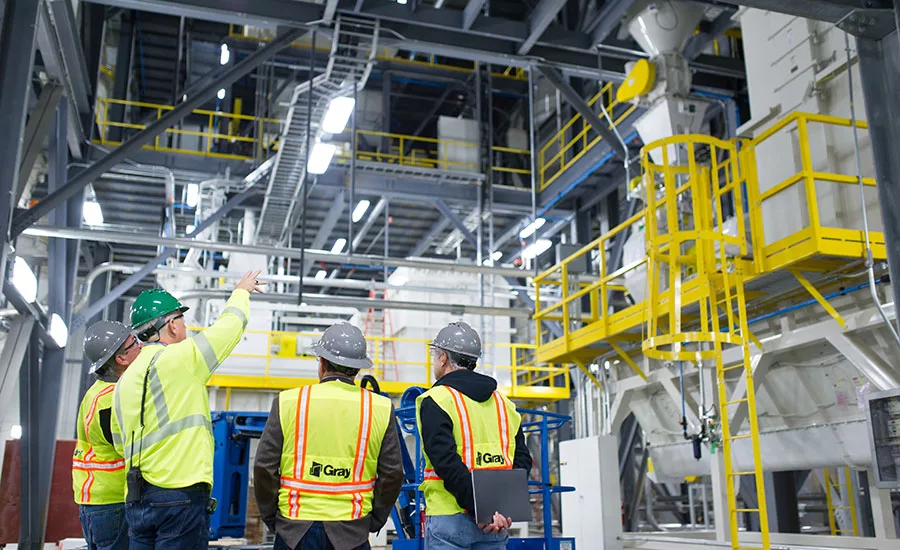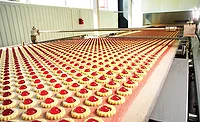Pet Food Series
Tomorrow’s pet food plant: What it takes to stay competitive
Plants of the future will rely on automation to produce consistent safe quality pet foods

In FE’s December 2019 feature, “Expectations for conveniently packaged specialty pet food create challenges,” we looked at how consumer demands for new—and sometimes—exotic pet foods are challenging pet food manufacturers today. We also looked briefly at how regulations are placing new demands on pet food processors.
In this article, I asked the experts interviewed for the December article to describe what the modern, competitive pet food plant of the future looks like. What are its key design considerations to make it fast, efficient and safe (e.g., product flow, building, internal and external environmental considerations, waste streams, automation, equipment, etc.)?
They came up with a detailed punch list, which appears below.
Modern pet food processing plants need to be flexible to handle today’s and tomorrow’s product and packaging needs. For retorts, this means designing in features (“future-proofing”) that allow processors to transition easily to different products and/or package handling capabilities down the road. Attention needs to be paid to ensure safe, efficient, and hygienic product flow—and to have systems in place for efficient energy and water usage. Increased levels of automation will be the key to profitability and product consistency.
—Jeff Arthur, Allpax
Building a fast, efficient, and safe pet food plant should include a single direction flow of material from raw to finished product. If available, room for future expansion should be planned in a manner that will not jeopardize the existing production flow. Automation is the new era of food safety, and as an industry we will see the push to automate as many simple tasks as possible.
—Lindsay Schroeder, Dennis Group
The modern facility is designed to manufacture in a linear flow with easily defined and maintainable zones of segregation. Personnel and material transitions are kept to a minimum. Building design and finishes are aligned to the functions within each hygienic zone. Space temperature and humidity control is enhanced. Movement of materials to and from the lines is optimized to ensure clean and clear paths of flow. Material management is consolidated to reduce the ad hoc storage that tends to spring up around production lines when material movement is inefficient. Personnel movement and material movement are coordinated and segregated to the extent possible to enhance safety. Shared functions between pre-kill and post-kill zones are carefully evaluated and positioned such that they can efficiently service either zone while minimizing the potential for cross contamination. In some cases, shared functions such as shift change transitions, break rooms, parts storage and cleaning are best segregated or separated. The benefits to product quality in these cases outweigh the convenience and benefits of co-mixing of staff.
—Jeff Matis, CRB
Pet food manufacturers should be closely looking at digitization and smart manufacturing. The accumulation of data from critical points throughout the supply chain enables identification of opportunities for improvement. Today, more than ever, essential elements of an agile supply network include improvements in efficiency, eliminating waste and understanding customer demand.
Supply chain agility is more important than ever. With the emergence of e-commerce and the constant evolution of trends and customer expectations, supply chain strategy must be resilient to change. Change becomes a constant and comprehensive data that can quantify the impact and magnitude of change will enable effective management.
Manufacturing isn’t the only industry adjusting to changes as critical data becomes readily available. Capital execution and project delivery work processes are incorporating lean concepts to improve information, resource and material flow to improve agility and yield higher returns on investment.
—Dustin Gill, Burns & McDonnell, Food & Consumer Products
The plant of the future will actually be designed on some very basic, old-school, supply-chain principles. Protect your people, protect your product, make the quantity scheduled on time and on quality. Every design decision should be examined through this lens.
- Protect your people: What is the flow of people, traffic, and materials? Is the work environment safe? Is it ergonomic? Is there adequate room for cleaning, changeovers, and maintenance? Was the design done with Safe Project Design principles?
- Protect your product: Is the product being produced at quality? Is it safe for the consumer? Can the lines and equipment be easily sanitized? Are all SQF/cGMP/FSMA rules adhered to? Are the latest materials and design concepts—from floor coatings to sanitary design of roof trusses—being used? Are the individual pieces of equipment designed for ease of cleaning, operation, and maintenance?
- Make the right quantity, on time: Is the plant designed for short runs and quick change-overs? Are your process controls, automation, and material handling such that you can hit your production goals every day? Are your outages and downtime occurring by plan? Is your maintenance reactive or predictive? The plant of the future is expected to run!
The high-tech twist to all of this will be to allow for a future of even greater automation inside and outside the walls of the facility. Plan for ever improving technology, such as a greater number of AGV’s inside the plant and warehouse, and self-driven trucks.
The plant of the future has to be flexible to allow for new products and allow for growth!
—Sam Thurber, SSOE
I think we’ll start to see a lot more advertising for successful third-party audits. It wouldn’t surprise me at all to see SQF logos on every pet food bag, along with marketing to educate consumers on the value of that logo. Major retailers are already requiring this, so the next logical step would be making consumers aware of these certifications.
The other major step will be flexibility. The trends of today will absolutely not be the trends of tomorrow. But you still need to buy some equipment, and you hope that equipment will serve you for the next 10-20 years. The major trend has been more and more focus on equipment that can adapt to alternate sizes and/or products as needs change.
—Steve Bain, Festo Corporation
Today’s pet food manufacturers are looking for ways to boost production runs, simplify clean-up and sanitation, control ingredient costs, reduce changeover times between runs and increase the ability to produce a variety of product types and sizes, all with an emphasis on cutting cost but improving overall food safety. Automation of the complete process is a key trend in pet food manufacture from raw ingredient receipt and transfer, including various pneumatic transfer options, batch weighing techniques, and continuous feeding methods, all the way to the extrusion, and packaging steps downstream. All automated equipment designs will emphasize process and product safety, as well as discuss options in process design for minimizing overall down times for product changeovers and cleaning.
- For increased production runs, food manufacturers are searching for equipment partners whose designs provide them with versatile additions in production capacity, with an emphasis on process efficiency and product safety.
- Food safety and contamination avoidance is of utmost importance when handling any food product. Due to a variety of options available in safe and efficient process equipment design, it is very important that the equipment manufacturer be experienced in a variety of engineering design regulations and standards, such as EHEDG, FSMA, GFSI, USDA, 3-A, etc.
- More and more food manufacturers are requiring equipment suppliers to be capable of performing complete factory acceptance tests (FATs) at their facility prior to shipment. This ability to design a type of all-in-one, “modular” production skid has seen significance in providing complete food processing systems to remote plants of global organizations.
—Sharon Nowak, Coperion – EFD Business Unit
The pet food plant of the future utilizes automation to get the most out of current equipment and maximize overall equipment effectiveness (OEE), which is significantly affected by process variability. Variations in your processes can lead to incorrectly formulated products that stop production and require extensive rework, resulting in excessive amounts of unplanned downtime and a reduction in throughput. To combat this and keep your operations running, you need to be able to understand the sources of variability in your processes.
Emerson’s non-invasive process-sensing technologies can provide improved visibility into processes so that operators can identify the sources of variability and take corrective action. With the ability to cost-effectively instrument at multiple points in a processes, manufacturers gain enhanced insight through measurements of critical parameters that affect product quality.
The pet food plant of the future must not only keep processes in spec, but also must take preventative steps to improve asset reliability to avoid equipment failures that can bring production to a sudden stop. Having asset health information and alerts presented prior to the occurrence of unplanned events can prevent stoppages and reduce maintenance costs associated with emergency services caused by unexpected breakdowns. Condition monitoring technologies can leverage sensors, algorithms, and software to assess and communicate to operators the health of equipment and assets, allowing them to identify potential issues and engage in predictive maintenance strategies.
For example, Emerson’s Plantweb Health Advisor is a suite of preconfigured software applications that continuously analyzes both process and equipment data to provide an overall asset health rating for pumps, compressors, heat exchangers, cooling towers, and blowers. Pre-engineered algorithms continuously analyze process and asset data and provide online displays, trending, alarms, historization, key performance indicators, and Statistical Process Control (SPC) calculations.
—Joshua Friesz, Emerson
The perfect picture of a modern, competitive pet food operation is truly the Champion Petfoods’ project in Auburn, KY. Purpose-built from the ground up to advance Champion’s Biologically Appropriate™, Fresh Regional Ingredient and Never Outsourced mission, the 371,000 sq.-ft. operation features custom-designed kitchens for their award-winning dog and cat food brands, ACANA and ORIJEN.
Project Facts include:
- Building features:
- Structural precast shell, conventional steel roof
- Floor construction consists of slab on grade, rebar reinforcement
- Wall construction consists of structural precast, insulated metal panels
- Designed to meet the food safety and track-and-trace standards of the human food processing industry
- Employs clean in place (CIP) throughout, an automated cleaning system which ensures the proper time, temperature and turbulence for cleaning
- Connection through Allen Bradley hardware and software systems allows all cooking data from start to finish to be displayed in the kitchen control center in real time
- The DogStar track and trace system tracks ingredients at each location of use and stores all information in a two-dimensional package code, which can be traced back to an individual farm or ingredient supplier
- Kitchens feature a custom-built thermal twin extruder that is the first of its kind in North America
- Located on an 85-acre site, 30 acres of which are devoted to kitchen operations. The remaining property will stay primarily undisturbed, and feature walking paths and pet exercise spaces
- 14-month schedule
—Tyler Cundiff, Gray
To read the December pet food article, visit this link.
For more information (from the December story):
Allpax, www.allpax.com
Bühler Group, www.buhlergroup.com
Burns & McDonnell, www.burnsmcd.com/services/buildings/manufacturing-industrial-facilities
Coperion, www.coperion.com/food
CRB, www.crbusa.com
Dennis Group, www.dennisgroup.com
Emerson, www.emerson.com
Festo Corporation, www.festo.com/us
Gray, www.gray.com
JBT/Avure, www.avure.com
SSOE Group, www.ssoe.com
Looking for a reprint of this article?
From high-res PDFs to custom plaques, order your copy today!








